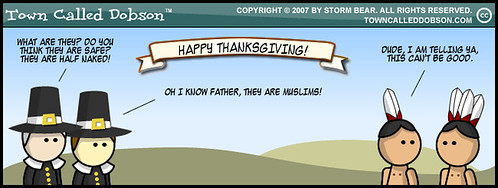 click to enlarge The Plymouth settlers (who came to be called “Pilgrims”) set apart a holiday immediately after their first harvest in 1621. They held an autumn celebration of food, feasting, and praising God. The Governor of Plymouth invited Grand Sachem Massasoit and the Wampanoag people to join them in the feast. The settlers fed and entertained the Native Americans for three days, at which point some of the Native Americans went into the forest, killed 5 deer, and gave them to the Governor as a gift. And we just kept thanking them… The Indian Removal Act, part of a U.S. government policy known as Indian Removal, was signed into law by President Andrew Jackson on May 28, 1830. The Removal Act was strongly supported in the South, where states were eager to gain access to lands inhabited by the “Five Civilized Tribes”. In particular, Georgia, the largest state at that time, was involved in a contentious jurisdictional dispute with the Cherokee nation. President Jackson, who supported Indian removal primarily for reasons of national security, hoped removal would resolve the Georgia crisis. While Indian removal was, in theory, supposed to be voluntary, in practice great pressure was put on American Indian leaders to sign removal treaties. Most observers, whether they were in favor of the Indian removal policy or not, realized that the passage of the act meant the inevitable removal of most Indians from the states. Some Native American leaders who had previously resisted removal now began to reconsider their positions, especially after Jackson’s landslide reelection in 1832. Most white Americans favored the passage of the Indian Removal Act and it passed after bitter debate in Congress. The treaties enacted under the provisions of the Removal Act paved the way for the reluctant—and often forcible—emigration of tens of thousands of American Indians to the West. The first removal treaty signed after the Removal Act was the Treaty of Dancing Rabbit Creek on September 27, 1830, in which Choctaws in Mississippi ceded land east of the river in exchange for payment and land in the West. The Treaty of New Echota (signed in 1835) resulted in the removal of the Cherokee on the Trail of Tears. Have a great Thanksgiving! Note: Town Called Dobson will be on hiatus until Monday, November 26th. |
Tuesday, November 20, 2007
Happy Thanksgiving!
Posted by
Storm Bear
at
5:44 AM
![]()
Labels: cartoons, comics, genocide, humor, indians, native americans, pilgrims, plymouth colony, thanksgiving, webcomics
Subscribe to:
Post Comments (Atom)








0 comments:
Post a Comment